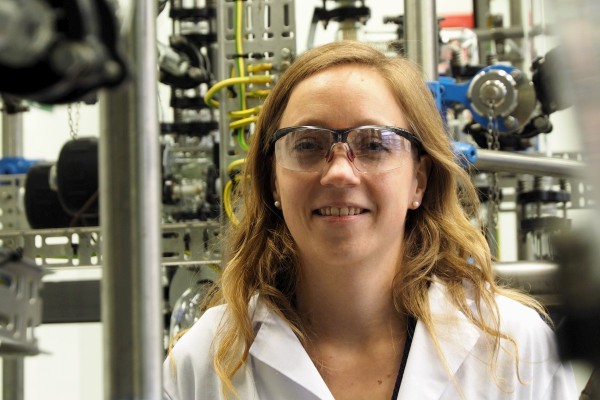Tucked away behind the large grounds of pharma multinational MSD in Oss is a conglomerate of fresh, ambitious life sciences companies united in the Pivot Park campus. Local government took over the redundant buildings after MSD took over the premises, and are leasing the sometimes fully equipped buildings to start ups that need space to grow. One of them is ChemConnection, a young contract research and manufacturing company for nanomedicines and active pharmaceutical ingredients. It was founded three years ago by former IMM graduate Gerjan Kemperman and Ferry Brands, and now has 35 employees.
Between lab and clinic
Silvie Meeuwissen was hired by ChemConnection in 2014 as a scientist and has already been promoted to project manager. The company operates between the lab and the clinical trials, Silvie explains. 'This means when a customer has found a new medicine that they believe is therapeutically active, they need to proceed towards clinical testing. We make the larger quantities of the compound and do the elaborate analyses that are needed for this, within a GMP environment. I am involved with a project from the very beginning when a customer first enquires about the possibilities. Then, I lead a team of chemists and analysts to develop and cGMP manufacture larger scale quantities of the compound.'
Silvie enjoys her work in industry a lot, she says. 'I like the challenge of successfully finishing a project. One of the products I helped develop is now tested in clinical trials and looks good. It is a cancer medicine encapsulated in a polymer nanoparticle. It is very satisfying to see that a product which I made can actually be a successful medicine.' Presently, she is involved in a completely different project making metal nanoparticles. 'I like this diversity in my daily activities. I am very happy with the goal-oriented way of working. The customer's wishes are leading and there is a clear timeline for a project.'
Fundamental or applied
Silvie studied chemistry in Nijmegen and did her Master's research with Floris Rutjes on organic synthesis. She looked around for a different subject to do her PhD research and ended up within the IMM again with Jan van Hest. In this project Silvie found the diversity she looked for. Several branches of chemistry came together such as small molecule synthesis as well as polymer synthesis, fabrication of nanoparticles and modifying the surface with enzymes of functional groups. The original plan for the research was to make defined clusters of nanoparticles in which a biocatalyst could be contained. But the clusters would not form and Silvie decided to shift towards designing the nanoparticles in various shapes and modifying them with compounds on the outside. It is very fundamental research but it does have a practical use, she explains: 'You can imagine that the shape of the particle determines how the body react to it. For example, we made particles with the shape of red blood cells.'
Although Silvie enjoyed her research at the IMM, she decided halfway through her PhD that she wanted to move to industry after graduation. 'I felt that my work was too fundamental and not directly useful to society. I thought I would find a more applied job in industry.' But at the time she graduated, the economic crisis had had its effect and there was a lot of competition for a few jobs. Silvie found that having a PhD was not much of an advantage as the number of jobs for highly educated chemists is not large. To stay up to date, Silvie accepted a postdoc position again within the IMM, doing research for the spin-off company FutureChemistry. There, she synthesised radiolabeled medicines so these can be easily followed in the body. An open application at ChemConnection finally got her the desired position in an industrial environment.
'I would advise anyone to do a PhD. During those four years there are many skills you learn that are applicable in other fields,' Silvie says. Besides chemical knowledge, she explains the main thing you learn during a PhD study is project planning. 'Each publication is a project in itself. As a PhD student, you are the one responsible for bringing it to a good end. In addition, communication and supervising skills that I learned are very useful in dealing with customers and project teams.'
IMM from the inside
Working within the extended environment of the IMM has many advantages, Silvie finds. 'There are so many disciplines represented here, ranging from biology to physics. It is easier to come in contact with scientists from other fields which makes it easier to get out of your own box and look at your subject from a different angle. There are many different collaborations within IMM.' Being a PhD assessor on the board of the IMM, Silvie was able to see the bigger picture clearly. In this position, she was the bridge between the board and the PhD students. She was present during board meetings, and when PhD related issues were discussed, she passed the information on to the students and vice versa.
What she will be doing a year from now is never sure, Silvie says. 'ChemConnection is such a young company that one can never tell what will happen next year. But I can fully imagine myself not working in the lab anymore and only doing planning and design. Besides, we are in the process of hiring a new PhD student that I will supervise. He or she will do his research for professor Jan van Hest of IMM and will work at ChemConnection.'
